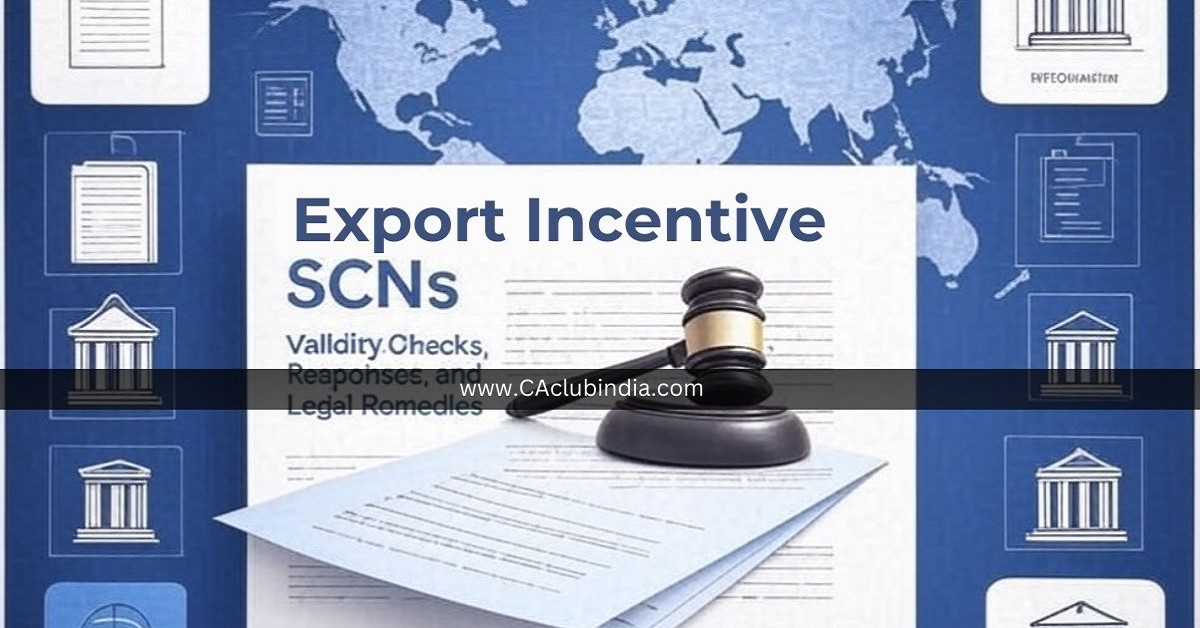Show Cause Notices (SCNs) are increasingly being issued seeking recovery of duty credit scrips granted under the Service Exports from India Scheme (SEIS) / Merchandise Exports from India Scheme (MEIS). These notices are issued under the Foreign Trade (Development and Regulation) Act, 1992 (the "FTDR Act") and the Foreign Trade Rules, 1993.
Before proceeding to reply or comply, it is critical that the validity of the SCN be examined. Certain legal grounds may be available to challenge such notices.

1. Initial Checks to Be Carried Out Upon Receipt of the SCN
The following points must be verified immediately upon receipt of the Show Cause Notice:
a) Competency of the Issuing Authority: It must be checked whether the SCN has been issued by the DGFT or the Central Government. If the SCN has been issued by any officer below the DGFT (e.g., Deputy DGFT, Joint DGFT), it would be without jurisdiction.
Under Section 16 of the FTDR Act, only the DGFT or the Central Government is empowered to review or recall an order related to the grant of scrips. Section 6(3) further prohibits the delegation of such powers to subordinate officers.
b) Limitation Period: The date of issuance of the duty scrip must be verified. It must be checked whether the SCN has been issued within two years from the date of grant of the scrip.
The proviso to Section 16 of the FTDR Act clearly mandates that a Show Cause Notice prejudicial to the interest of the recipient must be issued within two years from the date of the decision/order.
2. How to Respond to the Show Cause Notice
- After completing the above checks: A formal reply should be drafted, raising preliminary objections regarding lack of jurisdiction and/or limitation.
- It must be emphasized that: The issuing officer is not competent under the FTDR Act to initiate recovery proceedings.
- The SCN is barred by limitation if issued after two years.
- Supporting legal provisions (i.e., extracts of Section 16 and Section 6(3)) must be annexed with the reply.
- A request for quashing or withdrawal of the SCN should be made in the reply itself.
3. How to Challenge the SCN Legally (if necessary)If the authorities proceed despite submission of objections
- A writ petition may be filed before the appropriate High Court under Article 226 of the Constitution of India.
- The grounds for challenge would include: Absence of jurisdiction (SCN issued by a non-competent officer).
- Violation of statutory limitation (SCN issued beyond two years).
- Violation of principles of natural justice, if applicable.
4. Defenses Available Against Recovery SCNs
The following defenses are available:
- Ground Explanation: Lack of Jurisdiction SCN must be issued only by DGFT or Central Government (Section 16, FTDR Act).
- Time Barred Notice: SCN must be issued within two years from grant of scrip (Proviso to Section 16).
- Non-Speaking or Vague SCN: SCN must specify reasons; vague allegations are not sustainable.
- Violation of Natural Justice: No decision can be taken without giving proper hearing opportunity.
Conclusion
Before responding to any recovery notice relating to scrips, it must be carefully verified whether the notice complies with the FTDR Act. A detailed reply should be filed contesting the SCN on legal grounds if defects are found.
*Disclaimer: This article is intended for informational purposes only and does not constitute legal advice. Readers should consult with a professional advisor before taking any action based on this information.
The author can be contacted at gaauravarya@gmail.com






 CAclubindia
CAclubindia

